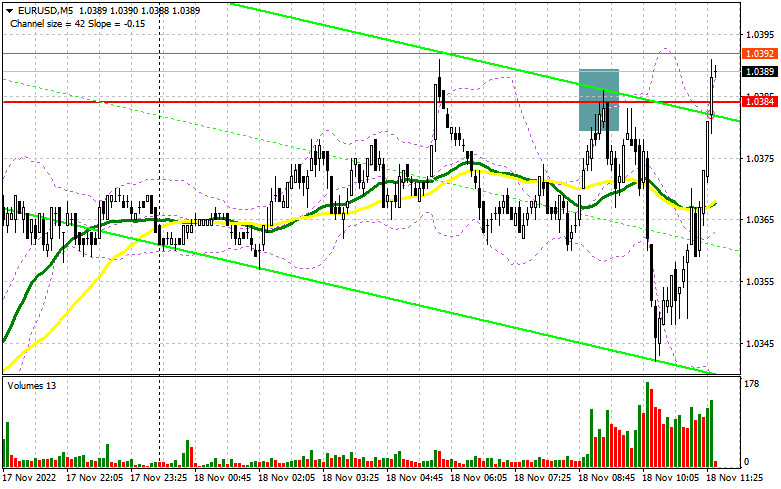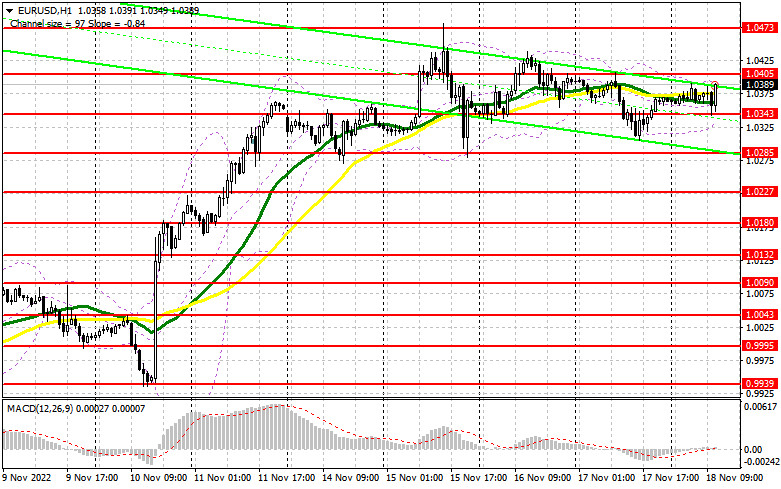
In my morning forecast, I paid attention to the 1.0384 level and recommended making decisions on entering the market from there. Let's look at the 5-minute chart and figure out what happened there. Growth to this level occurred quite quickly in the first half of the day, but buyers should have offered something higher on the second attempt. As a result, a sell signal was formed, and the downward movement was more than 40 points. In the afternoon, the technical picture changed.

To open long positions on EURUSD, you need the following:
Ahead of us, we are waiting for data on the volume of home sales in the secondary market of the United States. However, it is unlikely that this indicator will be able to change something radically. The bears tried to push the market in the first half of the day, but as we can see, the demand for the euro remains. During the American session, the buyers will prove themselves, ending the day on a positive note. Weak data on the housing market will contribute to this. If the overall situation remains stable and there are no active purchases above the resistance level of 1.0343, it is better to stick to trading in the side channel. The optimal solution for opening long positions will be a false breakdown in the area of the nearest support at 1.0343. This will signal to buy EUR/USD in the expectation that the upward trend will continue and the pair will return to the level of 1.0405 formed by yesterday's results. A breakout and a top-down update of this range will open the way to 1.0473 and strengthen buyers' positions, giving additional hope for a larger upward movement to 1.0525, where I recommend fixing the profits. With the option of a decline in EUR/USD during the US session and the absence of buyers at 1.0343, the pressure on the euro will return. This will lead to profit-taking and a larger decline in the pair. In this case, only a false breakdown in the support area of 1.0285, which acts as the lower boundary of the side channel, will be a reason to buy. I advise opening long positions on EUR/USD immediately for a rebound only from 1.0227, or even lower – around the minimum of 1.0180, with the aim of an upward correction of 30-35 points within a day.
To open short positions on EURUSD, you need the following:
Consider the pair trading in a side channel for the fourth day in a row, and it is unlikely that anything will change in the near future. If the US data turns out to be better than economists' forecasts, then we can count on a downward correction of EUR/USD at the end of the week, but this is unlikely. An unsuccessful attempt to grow above 1.0405 remains the best option for sale, leading to an excellent entry point, a decline in the euro to the middle of the channel, and the nearest support of 1.0343. Fixing and updating this range from the bottom up forms an additional signal with the demolition of buyers' stop orders and the fall of the euro to 1.0285, where I recommend fixing the profits. A more distant target will be the 1.0227 area, which will reverse the bullish trend. In the event of an upward movement of EUR/USD during the US session and the absence of bears at 1.0405, the bullish trend will continue to gain strength, opening the way to 1.0473 – the monthly maximum. If there is no one there, I advise you to postpone sales until 1.0525. The formation of a false breakout there will become an additional point for entering short positions. It is possible to sell EUR/USD immediately on a rebound from the maximum of 1.0568 with the aim of a 30- to 35-point downward correction.

Signals of indicators:
Moving Averages
Trading is conducted around the 30 and 50-day moving averages, which indicates market uncertainty.
Note. The author considers the period and prices of moving averages on the hourly chart H1 and differs from the general definition of the classic daily moving averages on the daily chart D1.
Bollinger Bands
In case of a decline, the lower limit of the indicator, around 1.0320, will act as support.
Description of indicators
Moving average (moving average determines the current trend by smoothing out volatility and noise). Period 50. The graph is marked in yellow.Moving average (moving average determines the current trend by smoothing out volatility and noise). Period 30. The graph is marked in green.MACD indicator (Moving Average Convergence / Divergence - moving average convergence/divergence) Fast EMA period 12. Slow EMA period 26. SMA period 9Bollinger Bands (Bollinger Bands). Period 20Non-profit speculative traders, such as individual traders, hedge funds, and large institutions, use the futures market for speculative purposes and to meet certain requirements.Long non-commercial positions represent the total long open position of non-commercial traders.Short non-commercial positions represent the total short open position of non-commercial traders.Total non-commercial net position is the difference between the short and long positions of non-commercial traders.